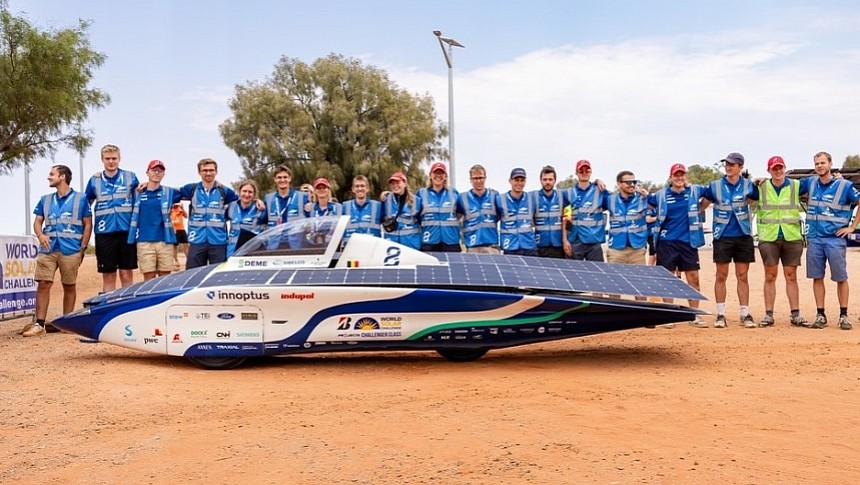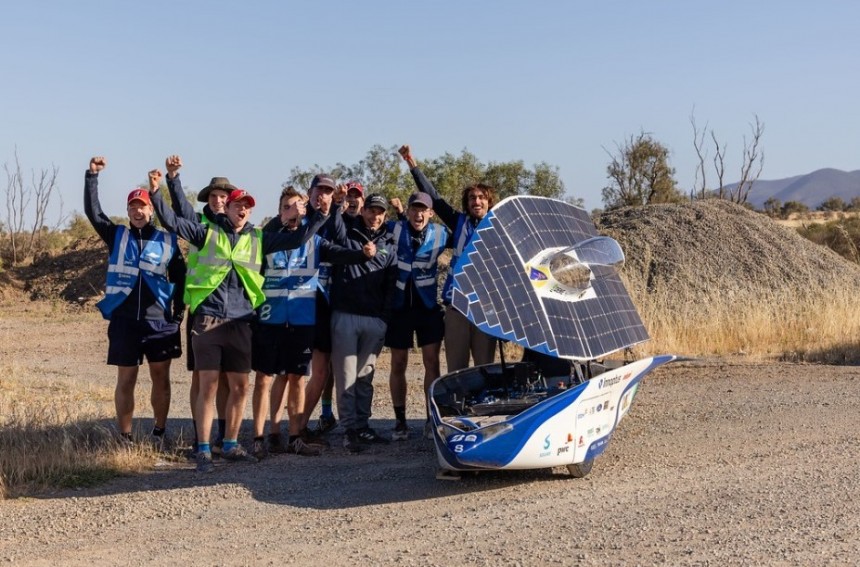Innoptus Solar Team, a bunch of students from Belgium, came up victorious in the world championship for solar cars after driving a little over 3,000 kilometers (1,864 miles) through the challenging Australian outback at the wheel of their million-dollar car "Infinite."
It may be a while before we start seeing solar-powered vehicles roaming the streets, but young engineers from around the world are already pushing the limits of car design with technological advancements and innovative solutions for the future of mobility. Many of these bright minds came together last week in Australia at the Bridgestone World Solar Challenge, the premier world championship for solar cars.
No less than 43 teams from 23 countries participated in the competition, putting their innovative solar vehicles through their paces across the Australian continent over the course of approximately five days. The participating cars had to travel the 3,020-km route from Darwin to Adelaide, relying on solar energy as their power source.
The Innoptus Solar Team from Leuven, a small Belgian city of just around 100,000 people, grabbed first place in the competition after racing against some of the best universities and engineering teams in the world.
Their Infinite solar car was an entry in the "Challenger Class," and this is not the first time the student team behind it has won gold at Bridgestone World Solar Challenge. They were also named world champions in 2019, which makes this win their second in a row, as the competition went through a four-year hiatus during the pandemic.
Infinite is a light, small, and incredibly aerodynamic vehicle with a bullet-shaped design and clad in photovoltaic solar panels. The single-seat car rolls on three wheels and features an innovative "fin" on top, which the team claims plays a significant role in the car's performance.
Inspired by marine animals, this fin is actually a retractable and rotating rudder whose purpose is to catch the wind to propel the car, reduce energy consumption, and enhance stability. The team first used this feature in last year's South African Solar Challenge, and it further developed the technology for this year's Australian event so that the driver could control it to achieve the optimal position for catching the wind.
"It’s a little bit like a dart effect. When you use the fin, you will pull back your centre of pressure. You’re trying to have a stabilisation effect. It’s the same as in an arrow: you have the mass on the point at the front, and you have your centre of pressure on the back," explains Christophe Chenut, one of the feature’s designers. "And even when the wind is not in the perfect condition to push the car, you can use the fin to stabilize the car."
The combination of an efficient solar array, a lightweight, high-capacity battery, and said fin on the car's roof was the team's recipe for success in this year's event.
During the competition, the team faced a few challenges, like wind gusts and the smoke from neighboring forest fires, which reduced the amount of solar energy captured by the car's panels. This meant the engineering students had to adjust their strategy to cope with the conditions, and the innovative fin allowed their car to maintain speed.
Infinite crossed the finish line with a time of 34 hours, four minutes, and 41 seconds and recorded an average speed of 88.2 kph (24.5 mph).
Solar racing cars like Infinite and others that entered the Bridgestone World Solar Challenge are a testament to the automotive engineers' relentless efforts to push the limits of what's possible in terms of energy-efficient vehicle design.
No less than 43 teams from 23 countries participated in the competition, putting their innovative solar vehicles through their paces across the Australian continent over the course of approximately five days. The participating cars had to travel the 3,020-km route from Darwin to Adelaide, relying on solar energy as their power source.
The Innoptus Solar Team from Leuven, a small Belgian city of just around 100,000 people, grabbed first place in the competition after racing against some of the best universities and engineering teams in the world.
Their Infinite solar car was an entry in the "Challenger Class," and this is not the first time the student team behind it has won gold at Bridgestone World Solar Challenge. They were also named world champions in 2019, which makes this win their second in a row, as the competition went through a four-year hiatus during the pandemic.
Inspired by marine animals, this fin is actually a retractable and rotating rudder whose purpose is to catch the wind to propel the car, reduce energy consumption, and enhance stability. The team first used this feature in last year's South African Solar Challenge, and it further developed the technology for this year's Australian event so that the driver could control it to achieve the optimal position for catching the wind.
"It’s a little bit like a dart effect. When you use the fin, you will pull back your centre of pressure. You’re trying to have a stabilisation effect. It’s the same as in an arrow: you have the mass on the point at the front, and you have your centre of pressure on the back," explains Christophe Chenut, one of the feature’s designers. "And even when the wind is not in the perfect condition to push the car, you can use the fin to stabilize the car."
The combination of an efficient solar array, a lightweight, high-capacity battery, and said fin on the car's roof was the team's recipe for success in this year's event.
During the competition, the team faced a few challenges, like wind gusts and the smoke from neighboring forest fires, which reduced the amount of solar energy captured by the car's panels. This meant the engineering students had to adjust their strategy to cope with the conditions, and the innovative fin allowed their car to maintain speed.
Infinite crossed the finish line with a time of 34 hours, four minutes, and 41 seconds and recorded an average speed of 88.2 kph (24.5 mph).
Solar racing cars like Infinite and others that entered the Bridgestone World Solar Challenge are a testament to the automotive engineers' relentless efforts to push the limits of what's possible in terms of energy-efficient vehicle design.















